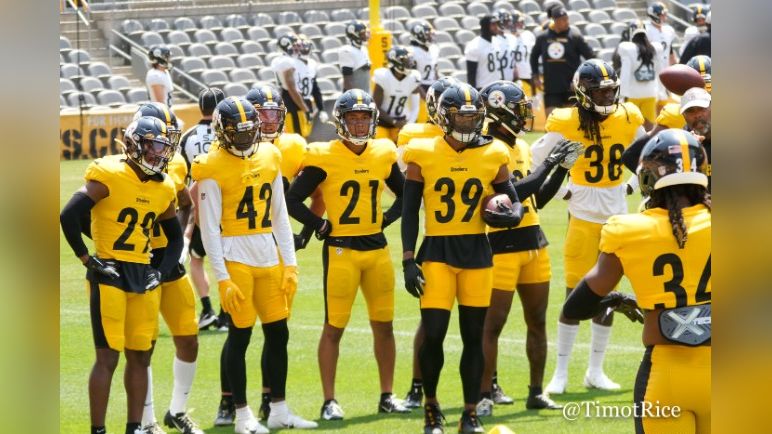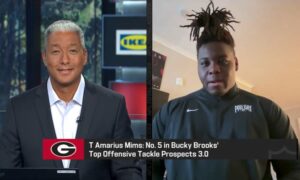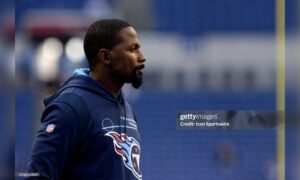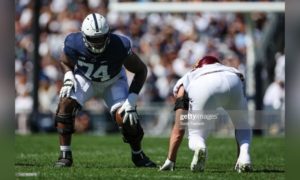The 2021 Steelers defense undeniably regressed as a unit when compared to the 2020 and 2019 units, both of which respectively finished top five in the league in points per game allowed. This past season, the unit finished 22nd in the league in points per game, allowing an average of 24.4 points per game.
While it is easy to focus on the 32nd ranked run defense, arguably the worst in modern franchise history, the Steelers had quietly fielded a top 3 pass defense in the league over the course of the two prior seasons before fielding a middle tier, 13th ranked unit in 2021. Even worse, after finishing atop the league in turnovers for consecutive seasons, the Steelers defense produced just 22 turnovers as a unit in 2021, good for 16th in the NFL.
After finishing top three in the league in 2019 and atop the league in 2020 with an opponent passer rating allowed of just 79.0, the Steelers defense saw that number climb all the way to 92.6 in 2021, good for 17th in the league. Simply put, the combination of allowing big plays at a higher rate and generating takeaways far less frequently caused the teams passing defense to struggle mightily at times this past season. Moreover, while it’s undeniably true that sacks don’t tell the whole story, and the Steelers inconsistent ability to generate consistent pressure contributes to the decline, talented secondary’s such as those in New England, Denver, and New Orleans were able to produce top ten pass defenses despite struggling front sevens which generated pressure at rates far lower than Pittsburgh’s.
After entering the 2021 season with two key departures in the secondary, including a boundary starter in Steven Nelson and a nickel starter in Mike Hilton, the struggles were somewhat predictable. As Cameron Sutton took over as a full time starter after two years of stellar play in the nickel, he struggled at times to contain receivers vertically and play the catch point downfield, but largely assumed his role as a competent boundary starter with sub package versatility.
Likewise, while his ability to generate turnovers took a dip, Minkah continued to produce, leading the team in tackles from the post safety position, keeping the team in numerous games with timely open field tackles and pass breakups. Expect Minkah to sign an extension this offseason that will put him near the top of the league in earnings at the safety position, keeping him and T.J. Watt together as the long term building blocks of this defense.
After showing signs in 2020, Haden appeared to have lost an extra step this past season, continuing to make veteran savvy plays, such as a game sealing tackle against Tennessee, yet far too often failing to show that he could contend opposing teams receivers downfield. While Haden’s time as a boundary starter in the league is likely done, a transition to a full time nickel or third safety type role in sub package could pave a path for him to remain in the league, although likely not in Pittsburgh.
Terrell Edmunds responded well this past season, continuing to improve even after the Steelers declined to pick up his fifth year option. Particularly in the run and screen game, Edmunds continued to prove that he is an above average box defender at the position, setting a new career high with 8 tackles for losses, all while continuing to provide effective man coverage against opposing tight ends. While he will never generate turnovers at a rate to justify his first round selection, Edmunds has proven to be a competent starter at the safety position, and compliments the ball hawking Minkah Fitzpatrick well, making it important for the team to retain him at a reasonable cost this offseason.
James Pierre entered the 2021 season with aspirations of taking a larger role in the defense after gaining a larger role ahead of a blowout playoff loss to the Browns. While he tackled well and showed physicality, far too often, Pierre was both unable to locate the football downfield and lacked the patience to contend with shallow and intermediate routes. After struggling mightily in a Week 12 matchup against the Bengals breakout star Jamar Chase, Pierre was demoted in favor of Ahkello Witherspoon, who was arguably the team’s best cornerback down the stretch. Entering 2022, with the potential loss of Joe Haden, Pierre will likely enter camp as a special teamer and depth piece, working to compete and regain a role in the teams sub packages, hopefully having learned from his first extensive snaps of defense.
Ahkello Witherspoon curiously struggled to find a role over the first 12 weeks of the season, leading many to question whether the Steelers had wasted a 2023 fifth round pick in trading for him. Regardless, after eventually assuming James Pierre’s role in Week 13, Witherspoon dominated down the stretch, providing tight man coverage in both off and press alignments, showing improved effort as a tackler, and most importantly adding great ball production. In fact, Witherspoon finished with a team leading nine passes defended and three interceptions despite playing in just nine games and starting just three, serving as evidence of both his dominant late season stretch and the teams broader struggles on the back end. Along with Terrell Edmunds and Montravius Adams, locking up Ahkello Witherspoon for a reasonable price on a long term deal should certainly be a top priority this offseason, as alongside Cam Sutton, he could give the Steelers a solid cornerback tandem on the boundary entering 2022.
Tre Norwood had about as good of a rookie campaign as could be expected from a 7th round draft selection, largely answering questions about his shaky tackling at the collegiate level and showing a strong ability to excel in man coverage on the inside as a dime defender. Not only was Norwood effective in assuming Sutton’s former role as the teams primary Dime defender, but he also showed the ability to play nickel cornerback on passing downs, as well as filling in for Minkah Fitzpatrick for a game at free safety, a testament to his high football IQ. Entering 2022, Norwood will continue to serve as a fixture in the teams sub packages, while also serving as a versatile top backup at both safety spots, not bad for a 7th round draft selection.
Arthur Maulet certainly had an interesting role in the defense in his first year as a Steeler this past season. Following the departure of Mike Hilton, Maulet was brought in to fill the void as a nickel cornerback with the ability to defend in the run and blitz off of the edge. Within that role, Maulet was impressive, finishing second to only Edmunds in the secondary in tackles for losses and leading the unit in quarterback takedowns. Regardless, he struggled mightily in coverage, to the point where he was subbed out in favor of Tre Norwood as the nickel on obvious passing downs, and did not have a role in the teams Dime package. Given Maulet’s struggles in pass coverage, where clearly lacks the size, speed, lateral quickness, and patience to succeed in man coverage assignments, he could potentially be retained in Pittsburgh for a very reasonable price, where he could continue to help replace the role formerly occupied by Mike Hilton.
After being jumped by James Pierre in the teams sub packages late last season, the writing was on the wall that Justin Layne would largely be relegated to special teams snaps in the 2021 season. With three years of league experience and no ball production to speak of, zero passes defended and zero interceptions thus far, it is safe to say that the lengthy, 6’2”, former 3rd round draft pick, will need to continue to play at a high level as a gunner to remain on an NFL roster. Ultimately, while Layne has certainly been solid as a gunner throughout his time in Pittsburgh, his roster spot is in jeopardy entering the 2022 training camp, where there will almost certainly be a mid round draft pick or free agent to push him for a backend roster spot.
Finally, Miles Killebrew, who was signed this offseason to be a core special teamer proved to be exactly that in Pittsburgh, most notably with two blocked punts, one of which spurred the Steelers Week 1 upset of the Buffalo Bills, and a second of which sparked a near 20 point comeback in Los Angeles. Beyond his sure tackling on the kickoff and punt units, Killebrew often served as a cornerback in the teams three safety packages on run downs, as well as in their goal line package. While his defensive value remains limited, Killebrew could certainly be a name the team could look to retain as a core special teamer in the first year of the post Ben era.
Minkah Fitzpatrick: 16 GP, 16 GS, 124 tackles, 84 solo, 1 TFL, 1 FR, 7 PD, 2 INTs, 55.7 rating allowed
Terrell Edmunds: 17 GP, 17 GS, 89 tackles, 63 solo, 8 TFL, 1 QBH, 6 PD, 2 INTs, 63.2 rating allowed
Cameron Sutton: 16 GP, 16 GS, 52 tackles, 44 solo, 4 TFL, 1 FF, 6 PD, 2 INTs, 116.9 rating allowed
Joe Haden: 12 GP, 11 GS, 38 tackles, 26 solo, 1 FF, 1 FR, 6 PD, 103.3 rating allowed
Ahkello Witherspoon: 9 GP, 3 GS, 15 tackles, 14 solo, 1 TFL, 9 PD, 3 INTs, 13.5 rating allowed
James Pierre: 17 GP, 4 GS, 47 tackles, 37 solo, 3 FF, 4 PD, 1 INT, 113.4 rating allowed
Tre Norwood: 17 GP, 3 GS, 38 tackles, 32 solo, 2 TFL, 4 PD, 1 INT, 119.1 rating allowed
Arthur Maulet: 16 GP, 2 GS, 47 tackles, 38 solo, 5 TFL, 2 QBH, 1 FF, 1 PD, 138.9 rating allowed
Justin Layne: 17 GP, 0 GS, 16 tackles, 12 solo, 1 FR
Miles Killebrew: 17 GP, 0 GS, 13 tackles, 9 solo, 1 TFL, 2 punt blocks
In total, while the Steelers secondary finished the year with 11 interceptions, slightly down from their previous year’s output, not having a single defensive back finish with over 10 pass breakups is the more concerning figure. As bad as things were, they could have been even worse if not for the team playing effective situational defense, finishing 11th in the league in both third down and red zone defense. Largely as shown by their passer ratings allowed when targeted, both Minkah Fitzpatrick and Terrell Edmunds were largely effective in both their man and zone coverage assignments this past season, as well as their open field tackling.
While Cameron Sutton’s rating is certainly boosted by long touchdowns which he allowed at points this season, I thought he finished the season well, forcing turnovers and tackling effectively down the stretch. Ahkello Witherspoon was extremely difficult for opposing quarterbacks to target down the stretch, using his length to disrupt receivers at the line of scrimmage and his range to close on windows in zone coverage. Regardless of his assignment, Witherspoon showed the ball skills to create splash plays at the catch point consistently, a characteristic that could help him compliment Minkah Fitzpatrick in resurrecting this defense’s ability to generate takeaways at a high level.
Overall, entering 2022, if the team is able to retain Witherspoon and Terrell Edmunds in free agency, while potentially getting back Stephon Tuitt and Tyson Alualu in the front seven, they would be best suited to return to their single high, Cover 1 centric defensive scheme which had them atop the league in 2019 and 2020. Simply put, if a team can not force quarterbacks to make tight window throws and consistently pressure them with a four man rush, said team will have no chance of competing with the league’s upper echelon offenses come playoff time. Depending on what happens in free agency, cornerback could end up being a potential mid round target for the Steelers in this year’s upcoming draft. I’ll be getting to work on profiling some potential fits for the team in the coming weeks.








